Blown wheel Nut
or
Blown fan axel
Ever wondered why F1 designers go to such trouble to refine the design of the front wings and particularly the endplates? Top teams bring something new in this area to almost every race.
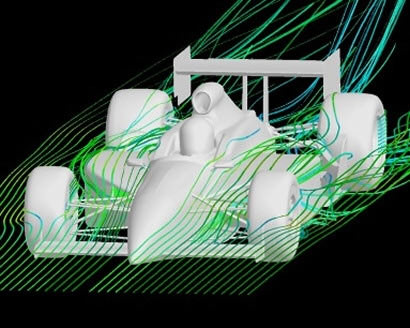
When you look down into this area of the Formula 1 design, you realize that it has far more effect on the aerodynamics of the rest of the car than many of as can think of! The front wing, unlike the rear, does not just provide downforce. As it is the aerodynamic device that precedes the entire car, it is also responsible to provide as clean flow as possible and for directing this airflow back towards the rest of the car. The optimal direction of this airflow is of critical importance to the overall downforce levels produced by the entire car. The most important part of the Formula 1 car aero is the front of the car, let's say first third of the car. Everything starts there. It is kind of black magic, making this work.
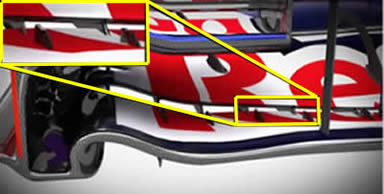 |
Vortex generators on Red Bull Racing car front wing are there to help to regulate vortices and air streams around and behind front tires and they can isolate high from the low pressure zones. Picture is from middle of the year 2013. |
F1 aerodynamic design at the front of the car focuses on a creating a powerful vortexes of air that starts from the front wing, flows inside the front wheels and then around the side pods and through the back of the car between the bodywork and the rear wheels. This vortex is important for sealing the gap between undertray and the track, and later to seal diffuser and to separate turbulent air created by rear wheel from rest of the airflow around very important diffuser and rear bodywork area. More powerful the vortex, the more downforce the car creates and the faster it goes around corners.
As the front wing endplate can only extend about halfway across the front tires following a rule change for 2014, it is all the harder to set this all important airflow up.
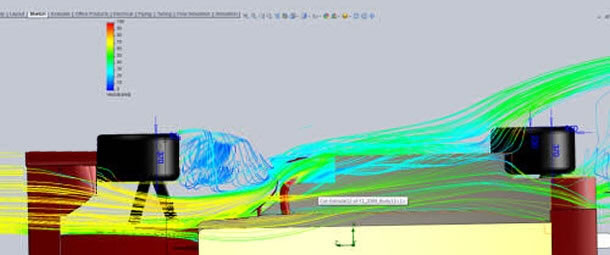
The tire create an effective wall, and produce what is called 'dirty air' behind them, an area of low pressure and high turbulence, that can disrupt the smooth flow of air around the rest of the car, and with it efficiency of undertray, diffuser and rear wing. The problems in creating clean air flow start with how you manage the airflows around tires and especially behind them, and the relationship between the front wing and the wheels.
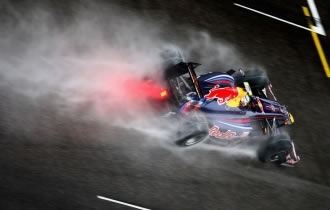 It is usually impossible to see this airflow - but there was a rare opportunity at the Brazilian Grand Prix a couple of years ago when a damp practice session meant it could actually be glimpsed on some of the cars.
It is usually impossible to see this airflow - but there was a rare opportunity at the Brazilian Grand Prix a couple of years ago when a damp practice session meant it could actually be glimpsed on some of the cars.
One, and for now most effective way to reduce this effect originally comes from Williams F1 team. Williams debuted this idea in 2013 on its Williams FW35, designed by Mike Coughlan. Solution is a so-called "blown front axle" or "blown wheel nuts". This is created by ducting the air from the brake ducts on the inside of the wheels, through a hollow axle and out of a hole in the wheel nut and over the spinning outer surface of the wheel. If the air from the brake ducts is not directed through the new hollow wheel nuts, it is a waste of air flow.
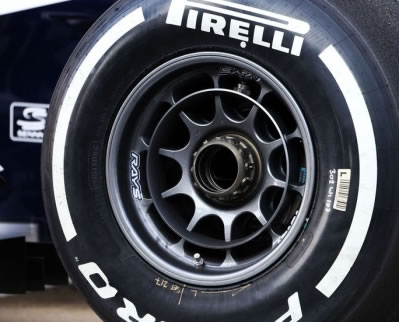 |
Williams debuted blown wheel nuts in 2013 on its Williams FW35, designed by Mike Coughlan |
The concept here is pretty simple. Because the front tires protrude outside the front wing, airflow is pushed around the outside of the wheels before flowing into the sidepods. Not entirely efficient. Without the blowing effect, the airflow coming off the front-wing endplate hits the front-tire and then, due to the curved shape of the wheel, follows the contour and is directed toward the cooling opening. This is a waste of critical flow.
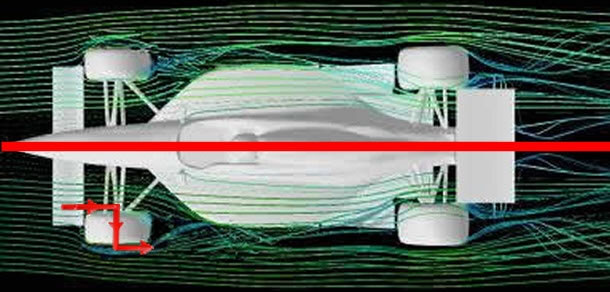 |
On upper part of the picture dirty air behind front wheel without blown front axle. |
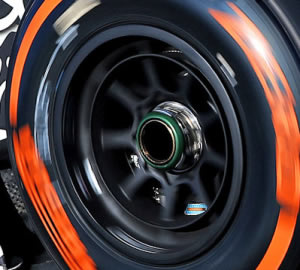 The oversized brake duct captures the airflow and splits it into two streams. Part of the air helps cool the carbon disk as usually is done, while the remainder feeds a channel running through the spinning axle and exits out of the centre of the hollow wheel-nut.
The oversized brake duct captures the airflow and splits it into two streams. Part of the air helps cool the carbon disk as usually is done, while the remainder feeds a channel running through the spinning axle and exits out of the centre of the hollow wheel-nut.
By using hollow axle and wheel nuts, the team can push this additional quantity of the air from inboard of the front wheel and injects a relatively smooth flow outboard with the aim of cleaning up turbulence in this area smoothing out the flow that will be reused further back down the car. This airflow, if it is powerful enough, can reduce the wake and turbulences around and, most importantly, behind the front tires from disturbing that vortex. By redirecting airflow into the wake of the front wheels reduces drag created by the front wheels as it decreases the low pressure area behind the front tire, helps balance air pressures, produce a “cleaner”  airflow going rearwards to the rest of the car, improves performance of the sidepods (cleaning the flow to the sidepod edge), undertray and diffuser and in the same time improve front brake cooling efficiency.
airflow going rearwards to the rest of the car, improves performance of the sidepods (cleaning the flow to the sidepod edge), undertray and diffuser and in the same time improve front brake cooling efficiency.
The only downside to this is the front brake ducts have to be larger to make this work, which will produce more drag, so as ever it will be matter of compromise to determine if it is worth it to have larger brake ducts in favor or getting more flow through the wheels. Larger brake ducts will increase drag, but more flow could help to control the wake that is created behind the wheels, creating a big impact on the efficiency of the car's floor and diffuser. On the picture left you can see Williams brake duct. Actually there are two ducts, smaller, outboard, for brake cooling and inboard, bigger one, for blown nut air supply. Click for bigger resolution.
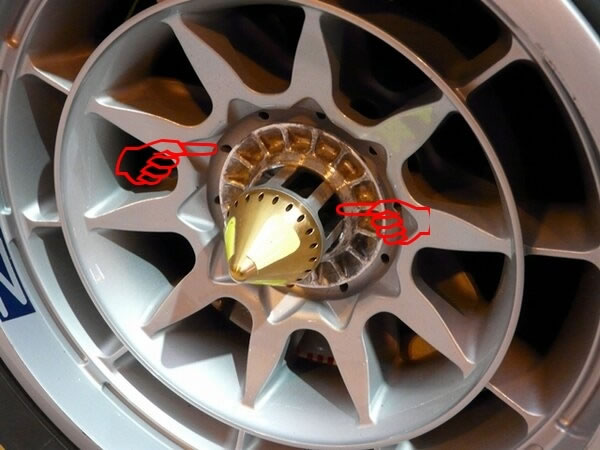
2013 Red Bull tried to implement a similar system, but fell foul of the rules. Their version achieved exactly the same but had the airflow exit outlets positioned at end of the axle and the exit holes were incorporated into the wheel rim. They rotated with it and protruded past the allowed aerodynamic extremity, which is why it was declared a “moveable aerodynamic device”, something which is against the regulations. This contravened the position of ducting and so was thrown out before it could be raced.
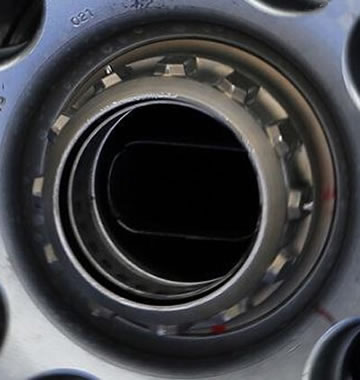 |
In the above image, launch version of the hollow wheel nut complete with duct-work. Williams have managed to keep their system separate to the axle by passing the air through a static tube within rotating axle. |
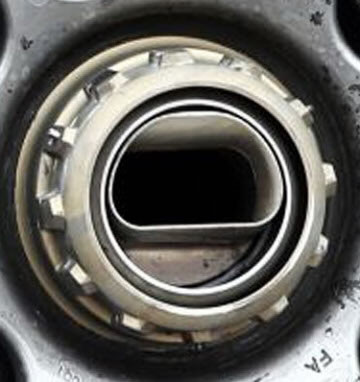 |
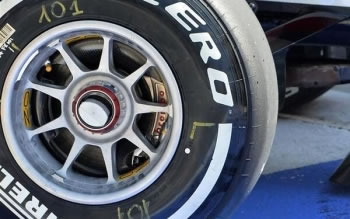 |
Ferrari managed to use a flow with opening of the pipe directioned on certain angle redirecting airflow where is much needed to control the wake that is created behind the wheels |
Williams have found a way to stay within the regulations and their system is legal and has been raced, something Red Bull failed to do. They have managed to keep their system separate to the axle by passing the air through a static tube within rotating axle, therefore making this legal. They have also designed the wheel nuts in such a way that they are flush with the wheel, thus avoiding the problems encountered by Red Bull which led to them having to change their design at 2014 Canadian Grand Prix.
Come preseason testing at Jerez 2015, and it appears that the blown wheel nuts have gained interest, different rims have been introduced at the same time to create the most efficient way to control the front wheels wake, a crucial property for the behavior of a Formula One car.
Three of the major teams have introduced the system into their cars. Red Bull (who were the first to introduce it), Ferrari and McLaren. The latter’s MP4-30 also has wider central hubs at the back, allowing the team to use the same wheel gun assembly front and rear.
All three of them also seem set to keep going with it, as none of these cars were seen with closed wheel nuts.
Ferrari has managed to design their blown-hubs with the fail-safe wheel nut included - the idea is actually believed to have come from Lotus after Ferrari signed their head of aerodynamics, Dirk de Beer.
Another important aspect of hollow axles, and nobody is actualy discusing it is lightnes of axle and front upright with this new developement. This will drasticly decrease unsprung weight in the front. Downside can be relative fragility because they will not be as resistant to an impact.
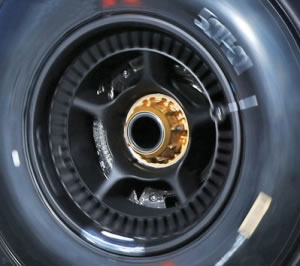 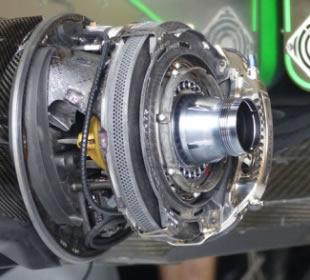 |
Back to the top of the page






